Several years ago, I was in my school hallway on the way to my mailbox, and noticed a young elementary child walk past a new student. This new student had Autism and was engaging in self-stimulatory behavior as he moved along the hallway. The younger child appeared confused, worried and concerned for the student with Autism .
My school had just created a self-contained class for students with disabilities. Because this was early October, it was early enough in the school year that for many of our students, this type of behavior was their first exposure to students with Autism and other disabilities.
My perplexed student watched as the stimming continued. She later approached me and asked, “What’s wrong with the boy who was screaming in the hallway? Is he okay?” Her question was so enlightening to me in many different ways. For starters, the child was genuinely concerned about the student and didn’t seem to have any idea what Autism was.

As I answered many of her questions, the conversation continued to what I considered an angelic quality. Her questions ended up addressing how students with Autism were similar to her. For example, can students with Autism dance? Talk? Smile? Laugh at jokes? Play videogames? Have favorite colors? It was truly an eye-opening and enlightening conversation.
As a child I had two cousins with Down syndrome. I did a lot of volunteer work for the Special Olympics and I used to teach swimming lessons to students with special needs. I’d forgotten that most students don’t get to be around the kind of diverse populations that I experienced in my youth.
This conversation with my student made me realize that while I was trying so hard to make sure my new students with disabilities were included in all activities and their individual needs were being met, I was overlooking many opportunities to bridge the gap between students with and without disabilities in my Physical Education classes.
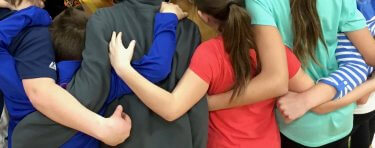
As physical educators we teach our students that all of us share similarities and differences, but we don’t spend much time talking about disabilities: what they are; how they may present; proper etiquette when interacting with a person with a disability; and how different obstacles can be overcome.
For example, we need to teach our children why some students have motor tics, why some students participate in self-stimulatory behaviors, why some students can only communicate with an iPad, etc. Understanding leads to acceptance. Acceptance leads to inclusion. Inclusion is so much bigger than just being placed in a regular class within the school. It’s about being embraced and included in all aspects of a school’s activities and participating using ones own abilities as an active member of the class.
Talking to my students led me to ask myself, “Was I truly including all students?” Sadly, the answer was NO. Worse yet, I was missing out on one of the greatest lessons I can teach my students; that we ALL need to understand each other and that by doing so, we can all learn to see each person’s God-given-talents.
All human beings, regardless of whether they have a disability or not, have the need to be loved, feel understood, valued, and connected, and have lasting friendships. The more I thought more about this, it became clear to me there was a lot I could do to change and improve my teaching. As PE teachers and coaches, we have the potential to have such a significant impact on our students’ beliefs and attitudes.
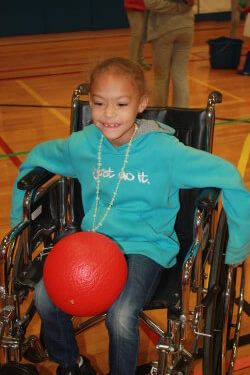
I began at my school by creating a unit called “Ability Awareness.” It has now grown into an annual school-wide November focus. At Lincoln Avenue ES, we teach our students how we all have unique abilities, and that these unique abilities can be used to help other people and make our community great. Our students learn that we all face obstacles in our lives, but these obstacles do not define us. They make us stronger!
This year, we kicked off our “Abilities Awareness” unit with an assembly from The Youth Alliance (TYA). TYA partners with schools to educate and empower students and communities. Chris Holyfield was our speaker. He is a WWE Smack Down Star; also know as “Little Boogeyman” who is 4 ft. 4 inches. But Chris is a little person with a huge heart and many talents. Chris empowered our students to believe they can accomplish their dreams no matter what obstacles may lay ahead of them and to try their best at all they do.
The most powerful moment for me during the assembly was when Preston Centuolo, one of the speakers, stopped talking and closed his eyes for a few seconds with his hands behind his back. He then explained to our students that he has a tic disorder and he needs to make certain involuntary movements. He told the students to please not tell him “I hope you feel better” at the end of the show because he was not sick and there was nothing wrong with who he was. As a mother of a child with a tic disorder and a teacher of many students with tics, I was so proud of Preston’s message!
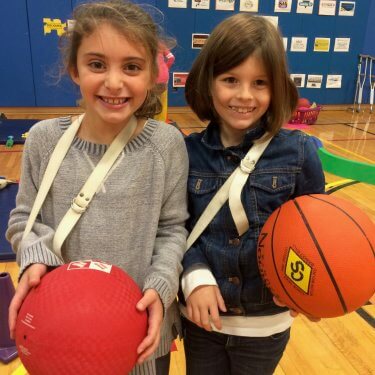
In my classes, I teach several activities emphasizing our similarities but also try to point out all the wonderful things that make us unique. I demonstrate how unique our abilities are through a Fitness Bingo activity. Students each receive a “Fitness Ability Bingo” board and a pencil. In each box, there is an example of an ability and an exercise that is paired with it. The students must race around the gym trying to find a student who has one of the different abilities listed (i.e. I can do a skateboard trick, etc.). Once they find a student with that ability, the student must sign off on the sheet and do the exercise listed in the box with their partner. Then they race around and find a different person to fill a different box. In this way, we are celebrating all our amazing abilities and all the things that make us unique.
I enjoy creating activities and games that focus on what students can do with appropriate access, technology, or training, rather then what they cannot do because of their disability. For example, I borrow different adaptive equipment from the Sayville Cabinet for the Sick that are used by people with physical disabilities. These include wheelchairs, walkers, hand cycles, etc. I have students use the wheelchairs and other equipment while participating in many of my physical education classes. We teach our students that students with disabilities can be just as competitive and athletic given the opportunity.
Over the years, I’ve created scavenger hunts and games that expose my students to Braille by having them translate the clues and tasks they find while hunting or playing. I’ve created Sign Language “Workouts of the Day” (WOD’s), Tabatas, and Sign Language Task Cards. While participating in these Sign Language activities, the students experience firsthand how students can communicate through sign language. I’ve also brought in examples of communication boards, communication books, cue cards, and Augmentative Communication Devices for my students to view and use with partners during certain activities or cooperative games. Through these exercises, the students learn firsthand an alternative communication method. Collectively, these activities show my students there is ABILITY in disability and that we all do things in different ways.
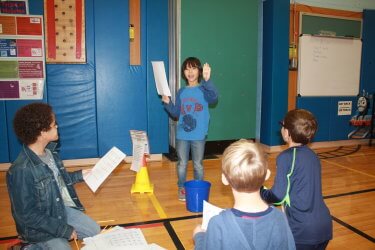
I’ve learned that it’s important to teach empathy. I’ll sometimes have my students move through different stations where I show them what it might feel like to have a specific disability. When talking about learning disabilities, I’ll have the students put headphones on then play background music while they are trying to listen and attend to my instruction or their peers (a challenge students with ADD face). I’ve also given them instructions in a different language they don’t understand to simulate a learning disability, or overwhelm multiple senses while they are trying to concentrate (Autism).
Other modifications I’ve tried include blindfolding students to simulate vision impairment, giving them crutches, sitting them in wheelchairs, or placing arms in slings to have them experience a physical disability, and having students try not to blink for a couple of minutes while reading and performing the Tabata to show a Tic disorder. All of these activities help explain the disability and what it might feel like. In sum, they emphasize the main focus of our Abilities Awareness unit – on what all people can do and how we can create a community.
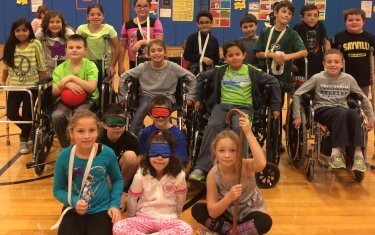
This year, we will conclude the unit with a Juvenile Diabetes Research Foundation (JDRF) 5K walk during school. We will be having the entire school, grades K-5 and their families, walk to raise money for a cure. The students will fundraise for JDRF for the month and donate all funds to JDRF in Daniel Panero’s honor.
Daniel is a student from Hauppauge who has Type 1 diabetes. He was selected to represent New York State at a national convention supporting diabetes research. Daniel has even gone to Washington, D.C. to attend the three-day JDRF Children’s Congress to raise awareness for Type 1 diabetes and speak with members of Congress about advancing research for the disease. To date, he has fundraised over $15,000 for JDRF. Daniel came to my school this fall to speak to our students about Type 1 Diabetes and all about his amazing accomplishments in advocating for awareness.
As you can tell, in the several years that have passed since that first unplanned hallway conversation with a concerned young student, in my school we’ve come a long way in understanding, adapting, accepting, and including all students!

Beth is such an inspiration to her students and colleagues. Seeing the world through the lenses of disabled people as an objective in these lessons is such a valuable opportunity for our children and promises to help our world become more inclusive.
The Lincoln Avenue community is truly blessed because Beth Bolger is a part of it. She’s fierce and knows how to be the change she wants to see. Our world is a better place because she is a part of it. Knowledge is power and the students are demonstrating this everyday with the knowledge and insight they gain from her.
Beth is such an inspirational teacher. Her diversified teaching approaches are so appreciated & admired by the students & faculty/staff who have the pleasure of knowing her!!
Hellison’s models completely changed my PE classroom for the better! I will be forever indebted to Don for his groundbreaking work
I couldn’t agree more Cindy!!
As a mother to two of Coach Bolger’s students, one of which is on the spectrum, I am extremely grateful that we are blessed to have her as a teacher in our school. Coach finds inventive ways to ensure that all students are included each and every day. She fosters an environment and culture among the students that encourage each of them to be their individual best and to accept one another. Thank you Coach for all that you do! You are an incredible role model for all students!
HI Beth! Way to go! Love this and is very timely as I am currently teaching a 1 credit Inclusive Activities class in conjunction with our 3 credit Adapted Physical Activity and Sport class offered at SUNY Cortland. I can’t agree more that children – our PETE majors – and teachers – need to learn empathy and to focus on a child’s ability – not what they can’t do! Thank you for sharing your great ideas! Best Tim
You are welcome and thanks for taking the time to leave a comment. Cortland is lucky to have you! Keep doing what your are doing for your PE majors!